Fungicides
The term fungicide normally applies to synthetic chemical compounds that kill fungi or inhibit their growth. However, certain biological organisms can also be used to control fungal infections, which include mildews, rusts and leaf spots.
 |
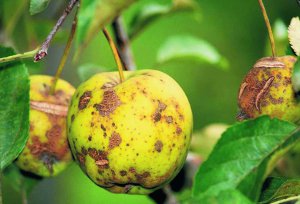 |
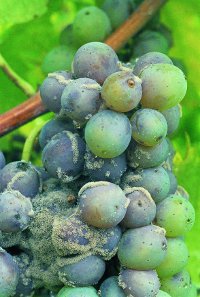 |
|
Figure 8 Some problem fungi on important crops. From left to right: potatop blight in its early stages; apple scab; grey mould on grapes. By kind permission of Bayer CropScience. |
Some fungicides offer protection against the development of fungi (termed protective), and others cure the plant by eliminating the fungus (termed curative).
Nearly all modern fungicides (except for inorganic salts, see below) degrade in aerobic soils and therefore they are environmentally friendly, the rate of degradation depending on the temperature and humidity.
Since fungi rapidly develop resistance to these chemicals, it is necessary to be able to draw on fungicides from different chemical classes and with different sites of action. The compounds discussed here are representatives of each important chemical class but the list is not exhaustive.
(a) Triazoles
The 1,2,4-triazoles are one of the most important classes of fungicide.
They offer protection against a wide range of fungi that occur in cereals, rice, beet, trees, vegetables and flowers. These include amongst others powdery mildews, leaf spot diseases and rusts. The triazoles inhibit important biochemical pathways that produce sterols which are essential components of cell membranes.
The compounds are applied to the leaf surface of the plant and are distributed all over the plant (systemic activity). They act by both preventing the action of the fungi by inhibiting the germination of the spores and also curing the problems caused by the fungi. They are thus both protective and curative.
Examples of commercially available triazoles include:
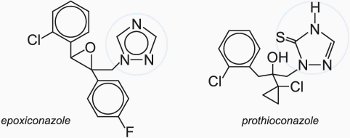
(b) Strobilurins
The development of a chemical class called strobilurins was inspired by the study of a group of naturally occurring fungicides, for example, strobilurin A.
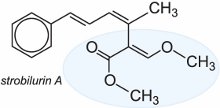
Strobilurins interfere with the production of adenosine-5'-triphosphate (ATP), the nucleotide that transports energy within cells for metabolism, thus preventing germination and growth. The strobilurins can combat most major fungal diseases found on grasses (turf), vines, fruit and particularly cereals.
Like the triazoles, they are systemic, and they offer protection and also cure the problems caused by the fungi.
Examples of commercially available strobilurins are given below:
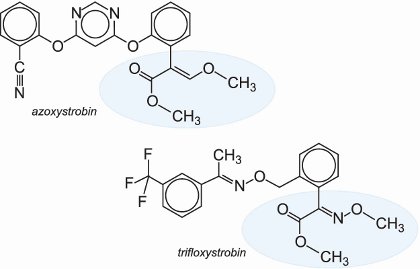
(c) Carboxamides
Carboxamides are so named as they contain the carboxylic acid amide (-CO-NH2) or related group. As with the strobilurins, they interfere with the production of ATP.
An example of a carboxamide fungicide is boscalid used in particular to control powdery mildew on fruit and vegetables.
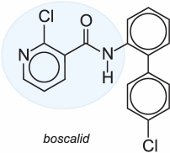
It is expected that several other compounds in this class will be commercially available in the near future examples of which are bixafen and isopyrazam.
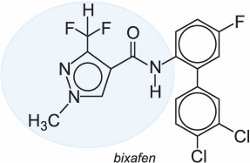 |
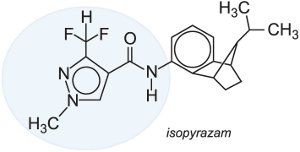 |
(d) Fungicides with a 'multi site action'
Besides fungicides which act mainly on one target enzyme, several fungicides with a 'multi site action' are commercially available. They act unspecifically on a number of enzymes and are therefore not very sensitive to resistance problems. They are all protectant fungicides, acting on contact with the fungal spores on the surface of the leaves.
Some examples are inorganic compounds such as elemental sulfur and some copper salts of which the 'Bordeaux mixture' (a mixture of copper(II) sulfate and calcium hydroxide) is the most famous. Both are allowed to be used in the production of organic food. Examples of organic compounds with a multi site action are salts of dithiocarbamates such as chlorothalonil and propineb. They are very widely used on a wide range of plant pathogens in fruits and vegetables such as grapes, apples, tomatoes and potatoes.
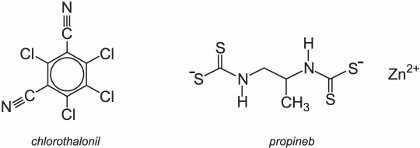
(e) Specific fungicides with activity against downy mildews
Since downy mildews are a special class of plant pathogens causing severe damage mainly in grapes and potatoes a number of specific fungicides active only against this kind of plant diseases are available. Most of them act systemically. Since they belong to different chemical classes they exhibit several modes of action.
Examples are metalaxyl and iprovalicarb:
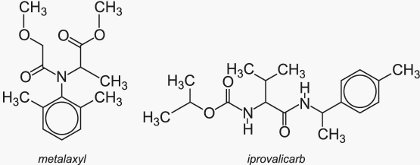
RELATED TAGS: FUNGICIDE CHEMICALS MAKING,FUNGICIDE CHEMICALS TO MAKE,FORMULATIONS OF FUNGICIDE CHEMICLAS,FORMULAS,FORMULA OF FUNGICIDE CHEMICALS,USES OF FUNGICIDE CHEMICALS,WHAT IS FUNGICIDE,WHY TO BE FUNGICIDE,FIGHT TO FUNGICIDE.
SOLVER CHEM

|
|

|
|

|
|


